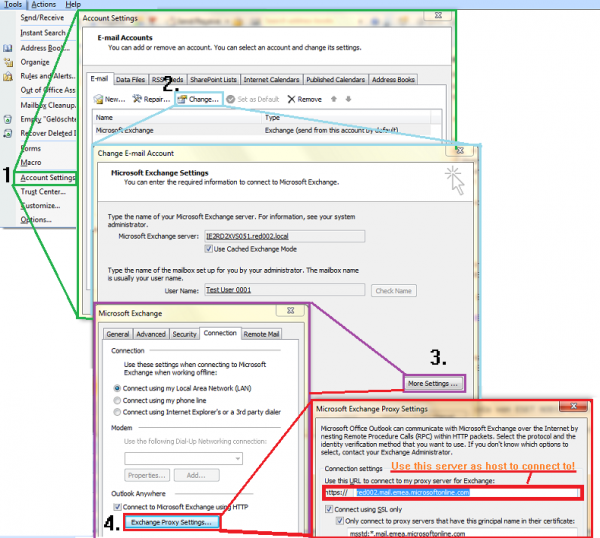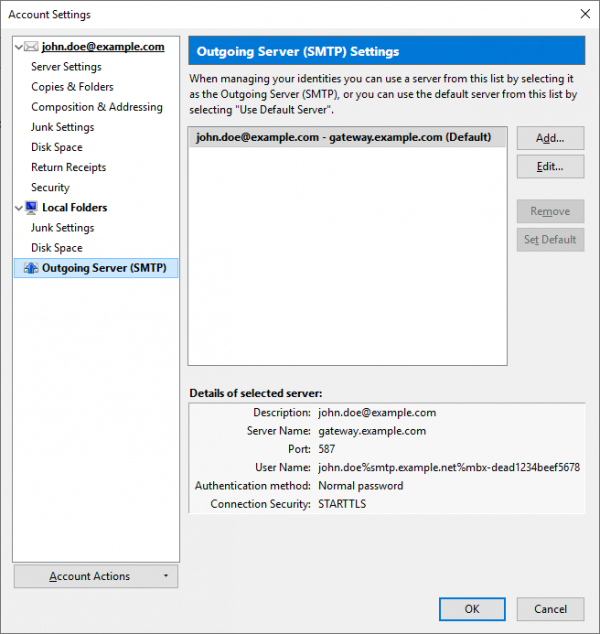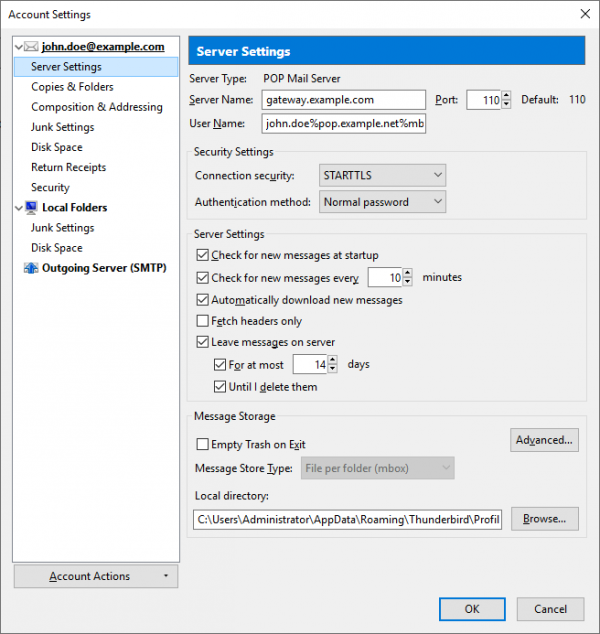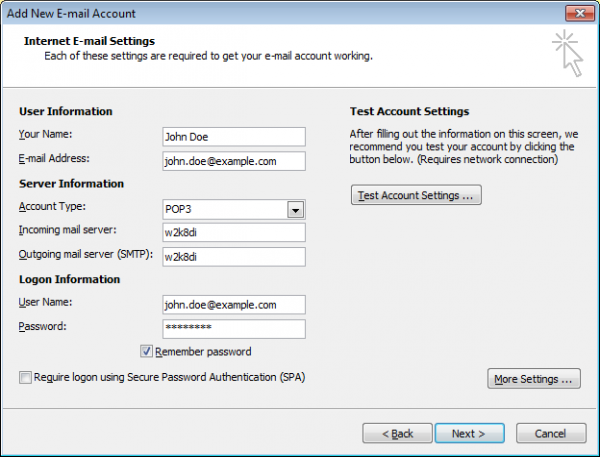Difference between revisions of "Archiving Emails Without Your Own Emailserver"
| [unchecked revision] | [unchecked revision] |
| Line 55: | Line 55: | ||
=== MailStore Gateway === | === MailStore Gateway === | ||
If sending and receiving emails via POP3/SMTP, the free program MailStore Gateway can be used as it provides POP3 and SMTP proxy functionality. Generally, MailStore Gateway is placed between the local email client (e.g. Thunderbird, Outlook, etc.) and the email server of the service provider. | If sending and receiving emails via POP3/SMTP, the free program MailStore Gateway can be used as it provides POP3 and SMTP proxy functionality. Generally, MailStore Gateway is placed between the local email client (e.g. Thunderbird, Outlook, etc.) and the email server of the service provider. | ||
| + | |||
| + | MailStore Gateway only supports encrypted connections to protect logon information and email content. The inbound connection parameters are used for the outbound connection to the original email server. | ||
==== Setup MailStore Gateway ==== | ==== Setup MailStore Gateway ==== | ||
| − | + | The following describes the general steps to setup MailStore Gateway for this archiving scenario. Please refer to the [https://help.mailstore.com/en/gateway/ MailStore Gateway Manual] for detailed instructions. | |
* Install MailStore Gateway on a machine which is able to connect to the internet. This can but does not have to be the same machine on which MailStore Server is installed. | * Install MailStore Gateway on a machine which is able to connect to the internet. This can but does not have to be the same machine on which MailStore Server is installed. | ||
| Line 63: | Line 65: | ||
* Create a new mailbox in MailStore Gateway. A single mailbox is sufficient in this scenario. | * Create a new mailbox in MailStore Gateway. A single mailbox is sufficient in this scenario. | ||
| − | Once a new MailStore Gateway mailbox has been created, | + | Once a new MailStore Gateway mailbox has been created, the configuration of the email clients can begin. On the ''SMTP Proxy'' and ''POP3 Proxy'' tab in the MailStore Gateway Management Console, the generic client configuration is shown. The below example should help to understand how the settings needs to be adjusted in particular, followed by instructions where to find the corresponding settings in well knows email clients. |
| − | + | '''Example''' | |
{| | {| | ||
| − | |||
| − | |||
| − | |||
! Email Provider Domain | ! Email Provider Domain | ||
| example.net | | example.net | ||
|- | |- | ||
| − | ! | + | ! Own Domain |
| example.com | | example.com | ||
| + | |- | ||
| + | ! MailStore Gateway Server Name | ||
| + | | gateway.example.com | ||
| + | |- | ||
| + | ! Mailbox ID | ||
| + | | mbx-dead1234beefdead5678beef | ||
|} | |} | ||
| − | + | '''SMTP Settings''' | |
{| class="wikitable" | {| class="wikitable" | ||
! | ! | ||
| − | !Old | + | !Old Value |
| − | !New | + | !New Value |
|- | |- | ||
!Server Name | !Server Name | ||
| Line 101: | Line 106: | ||
|} | |} | ||
| − | + | '''POP3 Settings''' | |
{| class="wikitable" | {| class="wikitable" | ||
! | ! | ||
| − | !Old | + | !Old Value |
| − | !New | + | !New Value |
|- | |- | ||
!Server Name | !Server Name | ||
| Line 123: | Line 128: | ||
|john.doe%pop.example.net%mbx-dead1234beefdead5678beef | |john.doe%pop.example.net%mbx-dead1234beefdead5678beef | ||
|} | |} | ||
| − | |||
| − | |||
| − | |||
| − | |||
==== Setup of Email Clients ==== | ==== Setup of Email Clients ==== | ||
| − | Next, configure your email clients for using MailStore | + | Next, configure your email clients for using MailStore Gateway (in the following described as using Mozilla Thunderbird and Outlook 2007). |
'''Mozilla Thunderbird:''' | '''Mozilla Thunderbird:''' | ||
| Line 135: | Line 136: | ||
* In Mozilla Thunderbird, open the mailbox settings via ''Tools | Account Settings'' | * In Mozilla Thunderbird, open the mailbox settings via ''Tools | Account Settings'' | ||
* Under ''Outgoing Mail Server (SMTP)'', select your current SMTP server and click on ''Edit'' | * Under ''Outgoing Mail Server (SMTP)'', select your current SMTP server and click on ''Edit'' | ||
| − | + | *: [[File:Client_settings_smtp.png|600px|center]] | |
| − | : [[File:Client_settings_smtp.png|600px|center]] | + | * Change the SMTP server being used and enter the DNS name or the IP address of the MailStore Gateway computer. |
| − | + | * Adjust the user name to match the format ''remote_username%target_server%mailbox_id'' where | |
| − | * Change the SMTP server being used and enter the DNS name or the IP address of the MailStore | + | ** ''remote_username'' is the user name (e.g. [email protected]) to login to a mailbox on ''target_server'' |
| + | ** ''target_server'' is the IP address or host name of the original email server (e.g. mail.example.com) | ||
| + | ** ''mailbox_id'' is the unique identifier of the MailStore Gateway mailbox into which copies of the sent or received emails are to be stored. | ||
* Click on ''OK'' to save the changes | * Click on ''OK'' to save the changes | ||
* To change the POP3 server, click on ''Server Settings'' | * To change the POP3 server, click on ''Server Settings'' | ||
| − | + | *: [[File:Client_settings_pop3.png|600px|center]] | |
| − | : [[File:Client_settings_pop3.png|600px|center]] | + | * Change the POP3 server being used and enter the DNS name or the IP address of the MailStore Gateway computer. |
| − | + | * Adjust the user name to match the format ''remote_username%target_server%mailbox_id'' where | |
| − | * Change the POP3 server being used and enter the DNS name or the IP address of the MailStore | + | ** ''remote_username'' is the user name (e.g. [email protected]) to login to a mailbox on ''target_server'' |
| + | ** ''target_server'' is the IP address or host name of the original email server (e.g. mail.example.com) | ||
| + | ** ''mailbox_id'' is the unique identifier of the MailStore Gateway mailbox into which copies of the sent or received emails are to be stored. | ||
* Save the new settings | * Save the new settings | ||
| − | Send a test email to verify the new settings. If they are correct, the email will be sent to the mailbox of the recipient | + | Send a test email to verify the new settings. If they are correct, the email will be sent to the mailbox of the recipient and a copy will is then stored in the MailStore Gateway mailbox with the given ID. |
| − | |||
'''Microsoft Outlook''' | '''Microsoft Outlook''' | ||
| Line 154: | Line 158: | ||
* Open the mailbox settings<br/>'''Outlook 2007:''' In the ''Tools'' menu, click on ''Account Settings''<br/>'''Outlook 2010 and higher:''' On the ribbon bar, click on ''File'' and under the menu item ''Information'' on ''Account Settings | Account Settings'' | * Open the mailbox settings<br/>'''Outlook 2007:''' In the ''Tools'' menu, click on ''Account Settings''<br/>'''Outlook 2010 and higher:''' On the ribbon bar, click on ''File'' and under the menu item ''Information'' on ''Account Settings | Account Settings'' | ||
* Select the appropriate account and click on ''Change'' | * Select the appropriate account and click on ''Change'' | ||
| − | + | *: [[File:Outlook07.png|600px|center]] | |
| − | : [[File:Outlook07.png|600px|center]] | ||
| − | |||
* Change the SMTP server as well as the POP3 server being used and enter the DNS name or the IP address of the MailStore Proxy | * Change the SMTP server as well as the POP3 server being used and enter the DNS name or the IP address of the MailStore Proxy | ||
| + | * Adjust the user name to match the format ''remote_username%target_server%mailbox_id'' where | ||
| + | ** ''remote_username'' is the user name (e.g. [email protected]) to login to a mailbox on ''target_server'' | ||
| + | ** ''target_server'' is the IP address or host name of the original email server (e.g. mail.example.com) | ||
| + | ** ''mailbox_id'' is the unique identifier of the MailStore Gateway mailbox into which copies of the sent or received emails are to be stored. | ||
* Save the changes by clicking on ''Next | Finish'' | * Save the changes by clicking on ''Next | Finish'' | ||
| − | Send a test email to verify the new settings. If all settings are correct, the email will be sent to the mailbox of the recipient | + | Send a test email to verify the new settings. If all settings are correct, the email will be sent to the mailbox of the recipient and a copy is stored in the MailStore Gateway mailbox with the given ID. |
'''In environments with branch- or home offices, please note:''' Please keep in mind that all email clients have to be set up for using the MailStore proxy server. Because of this, the email clients in branch- or home offices have to be routed through the main office for sending or receiving emails. This can be done by using a VPN connection, for example. | '''In environments with branch- or home offices, please note:''' Please keep in mind that all email clients have to be set up for using the MailStore proxy server. Because of this, the email clients in branch- or home offices have to be routed through the main office for sending or receiving emails. This can be done by using a VPN connection, for example. | ||
Revision as of 17:21, 28 February 2019
Please note: This article only addresses archiving methods in environments without an email server. It is assumed that you already have a MailStore Server installation or test installation and are familiar with the basic functionality of MailStore Server. Please refer to the Manual or the Quick Start Guide for more information.
MailStore Server offers several methods for archiving emails from an email server; they are described in the following. If you are not sure which archiving method is best for your company, please refer to chapter Choosing the Right Archiving Strategy.
Creating and Synchronizing User Accounts
When emails are archived, they are always assigned to individual users. For each user, whose emails will be archived with MailStore, a user account has to be created in MailStore. In addition to manually setting up new users, MailStore Server provides several options for importing existing user data.
Active Directory Synchronization
Within an Active Directory Domain Service environment, MailStore's internal user database can be synchronized with the active directory of your company. A description of this feature is available in the article Active Directory Integration.
Generic LDAP Server Synchronization
MailStore Server offers support for generic LDAP servers, which is described in detail in the article Generic LDAP Integration.
Using a CSV File
In relation with IMAP batch archiving, using a CSV file constitutes another option for importing user data. Detailed information about this topic is available in the article Batch Archiving IMAP Mailboxes.
Archiving Individual Mailboxes
Archiving Local Email Programs
MailStore supports archiving emails from locally installed email applications such as Microsoft Outlook, Windows Mail or Mozilla Thunderbird. This archiving method is especially useful for archiving historic data and is generally executed only once for each user. The emails located in the users' local profiles are placed in the central MailStore archive on the server. A detailed description of how to set up this archiving method is available in the article Archiving Email from Outlook, Thunderbird and others.
Once the dispersed inventory data has been stored in the MailStore archive, we recommend setting up central archiving profiles directly on the MailStore server for regularly archiving the user mailboxes. These are described below.
IMAP / POP3
Archiving individual mailboxes on any email server can be done using the IMAP or POP3 protocols. Information about setting up the archiving process is available in the article Archiving Server Mailboxes.
Microsoft Office 365
If you are using Microsoft Office 365, please follow the instructions in our article Microsoft Office 365.
Hosted Exchange
For archiving a Hosted Exchange mailbox, MailStore requires the access data for the email account made available by the provider. This includes user name (usually the email address), password as well as the (Exchange) server name.
Generally, the email application identifies the name of the Exchange server automatically using the autodiscover function (if supported by the service provider). This is why the server name is typically unknown to the user.
The server can be detected manually using the Exchange Proxy Settings in Microsoft Outlook. They can be found at Tools | Account Settings | Change| More Settings | Connection | Exchange Proxy Settings
The setup of the archiving process for a Hosted Exchange mailbox is the same as the setup for a single Exchange mailbox on a local Exchange server. Additional information is available at Archiving Individual Exchange Server Mailboxes.
Archiving Multiple Mailboxes in One Step
Batch Archiving of IMAP Mailboxes
Instructions for setting up Batch Archiving Of IMAP Mailboxes using a CSV file are available in the corresponding article.
Microsoft Office 365
If you are using Microsoft Office 365 or Microsoft Exchange Online, please follow the instructions in our article Microsoft Office 365.
Hosted Exchange
If your Hosted Exchange service provider offers setting up a "service account", this account can be used to archive multiple mailboxes in MailStore Server centrally. A "service account" is a user account with extended access privileges to multiple Exchange mailboxes. Additional information as well as detailed instructions for setting the appropriate privileges is available in our Exchange implementation guides:
Archiving Incoming and Outgoing Emails Directly
To implement the archiving of all incoming and outgoing emails directly without using a local email server, several methods are available depending on which protocols are supported by your email service provider:
MailStore Gateway
If sending and receiving emails via POP3/SMTP, the free program MailStore Gateway can be used as it provides POP3 and SMTP proxy functionality. Generally, MailStore Gateway is placed between the local email client (e.g. Thunderbird, Outlook, etc.) and the email server of the service provider.
MailStore Gateway only supports encrypted connections to protect logon information and email content. The inbound connection parameters are used for the outbound connection to the original email server.
Setup MailStore Gateway
The following describes the general steps to setup MailStore Gateway for this archiving scenario. Please refer to the MailStore Gateway Manual for detailed instructions.
- Install MailStore Gateway on a machine which is able to connect to the internet. This can but does not have to be the same machine on which MailStore Server is installed.
- Logon to the MailStore Gateway Management Console
- Create a new mailbox in MailStore Gateway. A single mailbox is sufficient in this scenario.
Once a new MailStore Gateway mailbox has been created, the configuration of the email clients can begin. On the SMTP Proxy and POP3 Proxy tab in the MailStore Gateway Management Console, the generic client configuration is shown. The below example should help to understand how the settings needs to be adjusted in particular, followed by instructions where to find the corresponding settings in well knows email clients.
Example
| Email Provider Domain | example.net |
|---|---|
| Own Domain | example.com |
| MailStore Gateway Server Name | gateway.example.com |
| Mailbox ID | mbx-dead1234beefdead5678beef |
SMTP Settings
| Old Value | New Value | |
|---|---|---|
| Server Name | smtp.example.net | gateway.example.com |
| Port | 587 | 587 |
| Security | STARTTLS | STARTTLS |
| User Name | john.doe | john.doe%smtp.example.net%mbx-dead1234beefdead5678beef |
POP3 Settings
| Old Value | New Value | |
|---|---|---|
| Server Name | pop.example.net | gateway.example.com |
| Port | 995 | 995 |
| Security | SSL/TLS | SSL/TLS |
| User Name | john.doe | john.doe%pop.example.net%mbx-dead1234beefdead5678beef |
Setup of Email Clients
Next, configure your email clients for using MailStore Gateway (in the following described as using Mozilla Thunderbird and Outlook 2007).
Mozilla Thunderbird:
- In Mozilla Thunderbird, open the mailbox settings via Tools | Account Settings
- Under Outgoing Mail Server (SMTP), select your current SMTP server and click on Edit
- Change the SMTP server being used and enter the DNS name or the IP address of the MailStore Gateway computer.
- Adjust the user name to match the format remote_username%target_server%mailbox_id where
- remote_username is the user name (e.g. [email protected]) to login to a mailbox on target_server
- target_server is the IP address or host name of the original email server (e.g. mail.example.com)
- mailbox_id is the unique identifier of the MailStore Gateway mailbox into which copies of the sent or received emails are to be stored.
- Click on OK to save the changes
- To change the POP3 server, click on Server Settings
- Change the POP3 server being used and enter the DNS name or the IP address of the MailStore Gateway computer.
- Adjust the user name to match the format remote_username%target_server%mailbox_id where
- remote_username is the user name (e.g. [email protected]) to login to a mailbox on target_server
- target_server is the IP address or host name of the original email server (e.g. mail.example.com)
- mailbox_id is the unique identifier of the MailStore Gateway mailbox into which copies of the sent or received emails are to be stored.
- Save the new settings
Send a test email to verify the new settings. If they are correct, the email will be sent to the mailbox of the recipient and a copy will is then stored in the MailStore Gateway mailbox with the given ID.
Microsoft Outlook
- Open the mailbox settings
Outlook 2007: In the Tools menu, click on Account Settings
Outlook 2010 and higher: On the ribbon bar, click on File and under the menu item Information on Account Settings | Account Settings - Select the appropriate account and click on Change
- Change the SMTP server as well as the POP3 server being used and enter the DNS name or the IP address of the MailStore Proxy
- Adjust the user name to match the format remote_username%target_server%mailbox_id where
- remote_username is the user name (e.g. [email protected]) to login to a mailbox on target_server
- target_server is the IP address or host name of the original email server (e.g. mail.example.com)
- mailbox_id is the unique identifier of the MailStore Gateway mailbox into which copies of the sent or received emails are to be stored.
- Save the changes by clicking on Next | Finish
Send a test email to verify the new settings. If all settings are correct, the email will be sent to the mailbox of the recipient and a copy is stored in the MailStore Gateway mailbox with the given ID.
In environments with branch- or home offices, please note: Please keep in mind that all email clients have to be set up for using the MailStore proxy server. Because of this, the email clients in branch- or home offices have to be routed through the main office for sending or receiving emails. This can be done by using a VPN connection, for example.
IMAP-Multidrop Mailbox
If your email service provider supports setting up and using an IMAP or POP3 multidrop mailbox, it can also be used to archive all incoming and outgoing emails in MailStore (as an alternative to using the MailStore proxy server). Setup procedures are described in the article Archiving IMAP and POP3 Multidrop Mailboxes.
Microsoft Office 365
If you are using Microsoft Office 365, the successor of Microsoft Business Online Productivity Suite (BPOS) and Microsoft Exchange Online, please follow the instructions in our article Microsoft Office 365.
Hosted Exchange
In order to archive all incoming and outgoing emails in a hosted Microsoft Exchange environment, it is required to set up journaling for all users or just a specific a distribution group of Exchange users. Please contact your hosting provider if this is possible. Information on how to archive emails from a journal mailbox can be found in our Exchange implementation guides:




